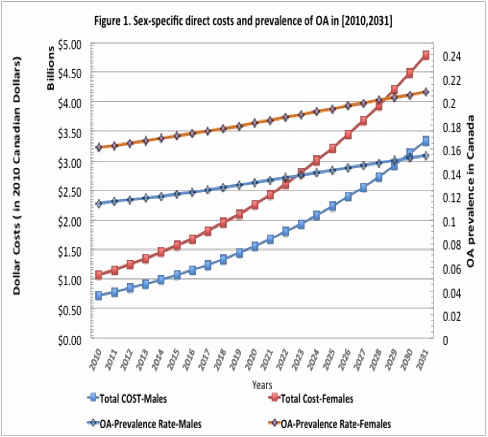Session Information
Session Type: Abstract Submissions (ACR)
Background/Purpose: POHEM-OA (Population Health Model-Osteoarthritis) is a population-based microsimulation model that uses Canadian Community Health Survey-2001 to generate the initial population and models every individual’s life history in terms of osteoarthritis (OA) diagnosis and treatment for the entire Canadian population. The objective of this study was to incorporate treatment and other costs of OA into POHEM-OA to project the future direct cost burden of OA in Canada for the years 2010 to 2031.
Methods: Average healthcare treatment costs were estimated from the British Columbia (BC) linked health administrative database spanning 1986/87 – 2003/03 that included physician visits, surgical procedures, medication, and all hospital admissions covered by the Medical Services Plan (MSP) of BC. Surgical procedures related to OA were micro-costed based on unit costs available from the fully allocated St. Paul’s hospital (Vancouver) cost model. Since the number of hip and knee replacements almost doubled in the last 10 years, replacement rates were recalibrated and a time trend was introduced based on the Canadian Joint Registry database from 1997-2007. Average drug costs (both over-the-counter and prescription drugs) were estimated from the PharmaNet (BC) database in 2003 and the National Population Health Survey for four main types of OA-related drugs (acetaminophen, NSAID, coxibs and opioids). Each patient was assigned a cost variable based on sex, age category, OA stage (defined by OA diagnosis, orthopedic surgeon visit, primary replacement surgery, and revision), and time in each stage. All costs were implemented in POHEM according to two categories: “ongoing costs” as they accumulated based on the person-years of each individual staying in a given OA stage and “event-based costs” for hip and knee replacement surgeries. A 5% annual discount rate was applied.
Results: The total direct costs of OA in Canada were estimated to rise from $1.8 billion dollars in 2010 ($0.7 and $1.1 billion dollars for males and females, respectively) to $8.1 billion dollars in 2031 ($3.3 and $4.8 billion dollars for males and females, respectively) (Figure 1). This rise is in part attributable to an increase in the number of persons living with OA, due to increasing OA incidence and general longevity. OA prevalence is projected to increase from 3 million (14%) in 2010 to 5.8 million (18%) in 2031 (Figure 1). Other contributing factors are the increasing number of total knee/hip replacements, greater use of services by patients treated surgically, and the aging of the OA population.
Conclusion: This population simulation model predicts a 350% increase in the total costs of OA over the next 20 years. The model will be helpful in the estimation of the economic consequences of potential changes in the prevailing model of care for persons with OA.
Disclosure:
B. Sharif,
None;
J. A. Kopec,
None;
M. Rahman,
None;
N. Bansback,
None;
E. C. Sayre,
None;
P. Finès,
None;
H. Wong,
None;
A. H. Anis,
None.
« Back to 2012 ACR/ARHP Annual Meeting
ACR Meeting Abstracts - https://acrabstracts.org/abstract/projecting-the-direct-cost-burden-of-osteoarthritis-in-canada-using-a-population-based-microsimulation-model-from-2010-2031/

